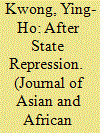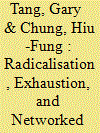| Srl | Item |
| 1 |
ID:
188953


|
|
|
|
|
| Summary/Abstract |
The Chinese government has imposed the National Security Law which has resulted in Hong Kong formally entering into a phase of movement abeyance. By analysing 3377 posts on LIHKG Internet forum, this article re-explores the online protest attitude during this movement abeyance. The findings indicate that content creators are more attentive in regard to criticizing the legislation and pro-Beijing figures, followed by seeking international support and calling for unity. Users are more ‘participative’ in calling for mutual destruction between the authorities and people, initiating mutual support and seeking emigration. This study provides new perspectives on the study of movement abeyance.
|
|
|
|
|
|
|
|
|
|
|
|
|
|
|
|
| 2 |
ID:
190187


|
|
|
|
|
| Summary/Abstract |
Between the Umbrella Movement in 2014 and the unprecedented mass protests in 2019, Hong Kong experienced a period of movement abeyance during which localism became a prominent political identification, notably among young people. Localism, defined as a reactive form of radicalism, was one pathway after a cycle of contention, alongside persistence with moderate claims and exhaustion, an affective process of detachment from contentious politics after mobilisation. However, the existing literature seldom explores individual attributes to these pathways during movement abeyance. Using survey data gathered from five local universities (N = 1,365), this study seeks to examine how cognitive appraisal of previous protest events, political emotions, and media use during abeyance predict radical and moderate political identifications among university students in Hong Kong. Youths with stronger devotion to the Umbrella Movement and negative emotions after it were more likely to identify as localists. However, youths with these attributes who perceived negative consequences of the Umbrella Movement showed a lower likelihood of being localists or pan-democrats. These results can elucidate the trajectories for radicalisation and exhaustion during post-Umbrella Movement abeyance.
|
|
|
|
|
|
|
|
|
|
|
|
|
|
|
|
| 3 |
ID:
188957


|
|
|
|
|
| Summary/Abstract |
Why does the Hong Kong diaspora mobilize transnationally to support the Anti-ELAB Movement back home? How do overseas mobilizations help sustain movement during its abeyance period? Building on the theoretical grounding from transnational movement and diaspora studies, I identify four dimensions of transnational ties that diasporas have with their homeland—relational, political, cultural, and identity and value—and examine their effect on diasporic activism in the host countries. Using original survey data on Hong Kong Americans and interviews with members of overseas Hongkonger groups, I demonstrate that attachment to Hong Kong culture and localist values are the strongest drivers for transnational engagement.
|
|
|
|
|
|
|
|
|
|
|
|
|
|
|
|